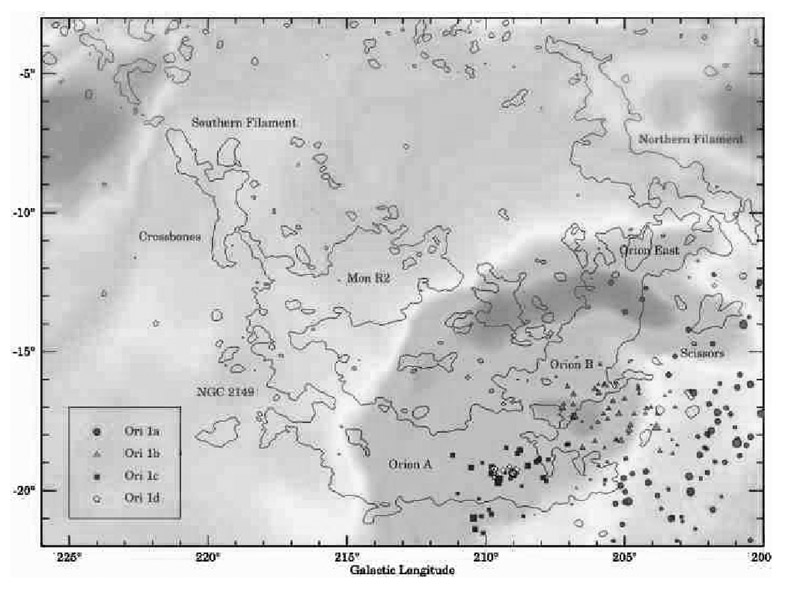
The region of Orion and Monoceros has unique importance as one of the great regions of active star formation in our galaxy. Its proximity and favorable position in the sky have made this one of the most extensively studied regions in the Milky Way. There are three prime components that comprise the Orion star forming region; 1) the giant Orion Molecular cloud which has been the repository of raw materials for forming stars in the last 12 million years, 2) the Orion OB1 stellar association containing the young hot stars formed from the Orion Molecular cloud complex, and 3) the last component being the assortment of fantastic HII regions that populate the region such as the Orion Nebula and the Horsehead Nebula region. These have formed as thin blisters of glowing gases over the surfaces of the molecular clouds, illuminated by the young massive stars of Orion OB1.
The Orion Molecular cloud is comprised of two distinct giant molecular clouds known as the Orion A and Orion B clouds, named after the HII regions formed within them (Orion A = M42, Orion B = NGC 2024). A dense ridge-like structure exists within the molecular gas of the Orion A and B clouds and represents the location of distinct cores of hot gas and dust where concentrated star formation is occurring. Many of these areas are identified only by their emission at radio and infrared wavelengths. These active regions of star formation are concentrated within an S-shaped ridge along the Orion A and B clouds roughly centered on the Orion Nebula. All of these regions are hotbeds of active ongoing star formation. Several of the more well known star forming areas are named and include the dense molecular cloud cores OMC-1, 2, and 3. Of particular interest is the infrared nebula known as the BN-KL nebula, located about one light year deep to the trapezium cluster within the OMC-1 cloud (Becklin-Neugebauer, Kleinmann-Low, 1967). This small region is one of the richest compact sources of protostellar objects known.
The illuminating power of the rich nebulosity found in the Orion region comes from the stars of the Orion OB1 association. The most massive and luminous stars within galaxies appear in groupings called OB associations. The strong collective winds from these massive stars coupled with the expanding shells of supernova remnants (the fate of most class O and B stars) produce large expanding shells of gas known as superbubbles. Cavities within these enormous shells are filled with hot hydrogen gas ionized by imbedded massive stars. The Orion molecular cloud complex is surrounded by an expanding supershell or superbubble of molecular gas called the Orion-Eridanus bubble. The immense superbubble has been inflated over the last 10 million years by the radiation of only 10 to 20 high mass O and B type stars of the Orion OB association. This immense cloud complex spans 15 degrees (400 light years) in diameter north-south and 40 degrees (1000 light years) east-west to encompass the constellations of Orion and Eridanus. The eastern boundary of the bubble is marked by a faint optical component well known as Barnard's Loop.
Star formation in the Orion clouds has almost certainly occurred by way of external sequential triggering where the supernovae and stellar winds of one generation have triggered the collapse of adjacent molecular clouds and the subsequent formation of a new generation of stars. The Orion OB1 association is remarkable by any standard. The association contains 56 OB giants (ranging from 06 to B2 stars) and several thousand lower mass stars, including many highly obscured protostars. The oldest subgroups of the Orion OB1 association are the 1a and 1b subgroups of the Belt region which are about 10 to 12 million years old. These older subgroups are now almost devoid of surrounding gas and lie at a greater distance from the molecular clouds than the younger groups, having since destroyed their parent molecular cloud. The 1c group lies within the Orion Sword region but projected about 60 to 200 light years in front of the Orion Nebula and the Orion A molecular cloud. The 1c group is about 3 to 6 million years old. The most recent group to form is the 1d subgroup which represents the stars of the Orion Nebula and NGC 1977. There are over 1000 stars in the Orion Nebula cluster which range between 1 and 4 million years old and include the young trapezium cluster which illuminates M42.

![]()
Courtesy of
![]()